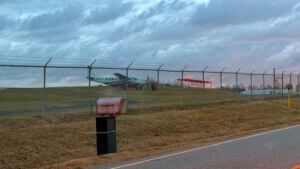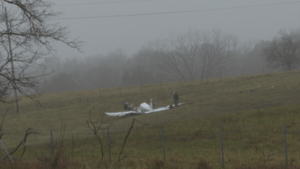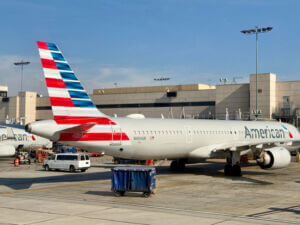These are the stories for today...
Today, the day before Thanksgiving, is a big travel day. Whether you're on the road with family or at work, be safe out there!
Tom
-
Aircraft slides off runway at Rowan County airport
By WSOCTV.com News Staff
ROWAN COUNTY, N.C. — Emergency crews responded to an aircraft experiencing engine failure at Mid-Carolina Regional Airport in Rowan County early Tuesday morning, officials with the Locke Township Fire Department stated.
responded to an aircraft experiencing engine failure at Mid-Carolina Regional Airport in Rowan County early Tuesday morning, officials with the Locke Township Fire Department stated.
The single-engine aircraft slid roughly 100 feet off the end of the runway.
No injuries were reported, officials said.
The incident occurred just before 7 a.m., prompting a response from multiple local agencies, including Locke Fire Department, Salisbury Fire, Bostian Heights Fire, South Salisbury Fire, Rowan Emergency Management, Rowan EMS, and the Rowan County Rescue Squad.
The exact cause of the engine failure has not been released.
Illinois State Police investigating deadly plane crash in Pike County
by KHQA News Desk
PIKE COUNTY, Ill — One person is dead after a plane crashed in Pike County Sunday night.
plane crashed in Pike County Sunday night.
The Pike County Sheriff's Office was told of the crash just before 9:40 p.m.
The plane reportedly went down into a field north of Interstate 72, west of Exit 35.
When a deputy made it to the scene, they found a person along the road, later identified as a passenger.
As more authorities arrived, they briefly searched for and found the wreckage.
A report from the FAA's Accident and Incident Notification system now indicates that three people were on board at the time of the crash: one pilot and two passengers.
The sheriff's office said the passengers were taken to local hospitals with what the FAA reports as serious injuries. One person, believed to be the pilot, was pronounced dead at the scene.
The FAA, NTSB and Illinois State Police are investigating the cause of the crash.
Assisting at the scene were the Griggsville Fire Department, Pittsfield Fire Department, Baylis Fire Department, North Pike Fire Department, The Pike County Ambulance Service, The Illinois State Police, Adams County EMA, Brown County EMA, The FAA and NTSB.
KHQA spoke with a pilot with numerous years of flying experience to get some context on the crash.
"It doesn't matter what the airplane is capable of. It comes down to what the pilot is capable of. And, I've been flying for 44 years...I would not attempt to fly five hours nonstop anywhere. It doesn't make sense to do that. And it's just not necessary. " Said Robert Katz, a private commercial pilot.
The NTSB takes about 30 days to send out a preliminary report on the crash, and the final report, which should include probable cause and contributing factors, won't be released for another 12 to 24 months.
https://newschannel20.com/news/local/illinois-state-police-investigating-deadly-plane-crash-in-pike-county-pittsfield-interstate-72-sheriffs-department-faa
Fumes onboard an American Airlines flight sent 5 to hospital
Zach Wichter
An American Airlines flight from Orlando to Phoenix was forced to divert to Houston on Sunday, Nov. 23, after the crew reported fumes in the flight deck and cabin.
Phoenix was forced to divert to Houston on Sunday, Nov. 23, after the crew reported fumes in the flight deck and cabin.
According to American Airlines, four crewmembers and one passenger were transported to the hospital in Houston.
A writeup from the Federal Aviation Administration, which is investigating the incident, said American Airlines flight 2118 was operated by an Airbus A321 and landed safely at George Bush Houston Intercontinental Airport after diverting.
American Airlines acknowledged the incident and said that passengers were transported to Phoenix on a replacement aircraft.
"On Nov. 23, American Airlines flight 2118 landed safely and taxied to the gate under its own power at Houston (IAH) following reports of an odor on board," a statement from the airline said, adding that first responders met the incident aircraft at the gate.
Toxic fume incidents on airplanes have gotten more attention in recent years, although flight attendants and other industry advocates say they have been an issue for decades. They're often caused by simple maintenance mishaps.
Most airplanes use what's known as a bleed air system, which pulls air through the engines into the cabin. When the engines are maintained properly, it's safe, but if their oil reserves are inadvertently overfilled, it can lead to chemical vapors mixing into the cabin air, leading to toxic fumes that can cause passengers and flight crews to feel sick.
Raychel Armstrong, an active flight attendant and vice president of Transportation Workers Union Local 577, told USA TODAY in 2023 that she had experienced toxic fume incidents more than once at work.
"We just started getting nauseous, I got a cough afterwards," she said. "This is normal for us, but it’s something that should never have been normalized in the first place."
A Wall Street Journal investigation found that toxic fume incidents were especially common on Airbus A320-family aircraft.
Zach Wichter is a travel reporter and writes the Cruising Altitude column for USA TODAY. He is based in New York and you can reach him at zwichter@usatoday.com.
https://www.usatoday.com/story/travel/airline-news/2025/11/25/american-airlines-toxic-fume-incident-houston/87463335007/
NTSB Final Report: Textron Aviation Inc T240
Pilot Reported That The Airplane Encountered A Crosswind Gust Just Prior To Touchdown
Location: Midland, Virginia Accident Number: ERA25LA150
Date & Time: March 15, 2025, 14:50 Local Registration: N918BM
Aircraft: Textron Aviation Inc T240 Aircraft Damage: Substantial
Defining Event: Abnormal runway contact Injuries: 2 None
Flight Conducted Under: Part 91: General aviation - Personal
Analysis: The pilot reported that the airplane encountered a crosswind gust just prior to touchdown, which pushed it to the left, and the pilot corrected with right aileron and left rudder. Upon touchdown, the pilot felt a “soft bump rather than the typical soft touch of the main [landing] gear,” which was followed by a “large bounce and porpoising.”
The nose landing gear collapsed, and the airplane sustained substantial damage to the fuselage and right wing. The pilot reported that there were no preimpact mechanical malfunctions or failures with the airplane that would have precluded normal operation.
Probable Cause and Findings: The pilot’s improper landing flare, which resulted in a bounced landing and the nose landing
gear collapsing.
FMI: www.ntsb.gov

Today in History
46 Years ago today: On 26 November 1979 PIA flight 740, a Boeing 707-300, crashed near Taif, Saudi Arabia, following an in-flight fire, killing all 156 occupants.
| Date: | Monday 26 November 1979 |
| Time: | 02:04 |
| Type: | Boeing 707-340C |
| Owner/operator: | Pakistan International Airlines - PIA |
| Registration: | AP-AWZ |
| MSN: | 20275/844 |
| Year of manufacture: | 1970 |
| Total airframe hrs: | 30710 hours |
| Engine model: | P&W JT3D-3B |
| Fatalities: | Fatalities: 156 / Occupants: 156 |
| Other fatalities: | 0 |
| Aircraft damage: | Destroyed, written off |
| Category: | Accident |
| Location: | 48 km N of Taif - Saudi Arabia |
| Phase: | En route |
| Nature: | Passenger - Scheduled |
| Departure airport: | Jeddah International Airport (JED/OEJD) |
| Destination airport: | Karachi International Airport (KHI/OPKC) |
| Confidence Rating: | Accident investigation report completed and information captured |
Narrative:
PIA flight 740, a Boeing 707-300, crashed near Taif, Saudi Arabia, following an in-flight fire, killing all 156 occupants.
Flight PK740 departed Jeddah at 01:29 for a flight to Karachi. The aircraft was climbing to FL370 when, at 01:47, a stewardess reported a fire near the aft cabin passenger door. The crew started a descent from FL300 and were cleared to descend to 4000 feet. Following a mayday call at 02:03 nothing more was heard from the flight. The aircraft crashed in a level rocky area at an elevation of 3000 feet and burst into flames.
PROBABLE CAUSE: "An in-flight fire in the cabin area which, through its intensity and rapid extension, resulted in panic among the passengers and smoke in the cockpit, eventually incapacitating the flight crew. The cause of the cabin fire was not determined."
It was considered that the origin of the cabin fire could have been a leaking gasoline or kerosene stove, carried aboard by Haj pilgrim passengers. Pressure differential could have caused a poorly sealed gasket to leak fuel.
A second possibility is an electrical fire, but the rapid extension of the fire was considered difficult to explain because of the electrical circuit protection devices of the Boeing 707. Sabotage was considered as another possibility, but no evidence of use of an incendiary device was found.
